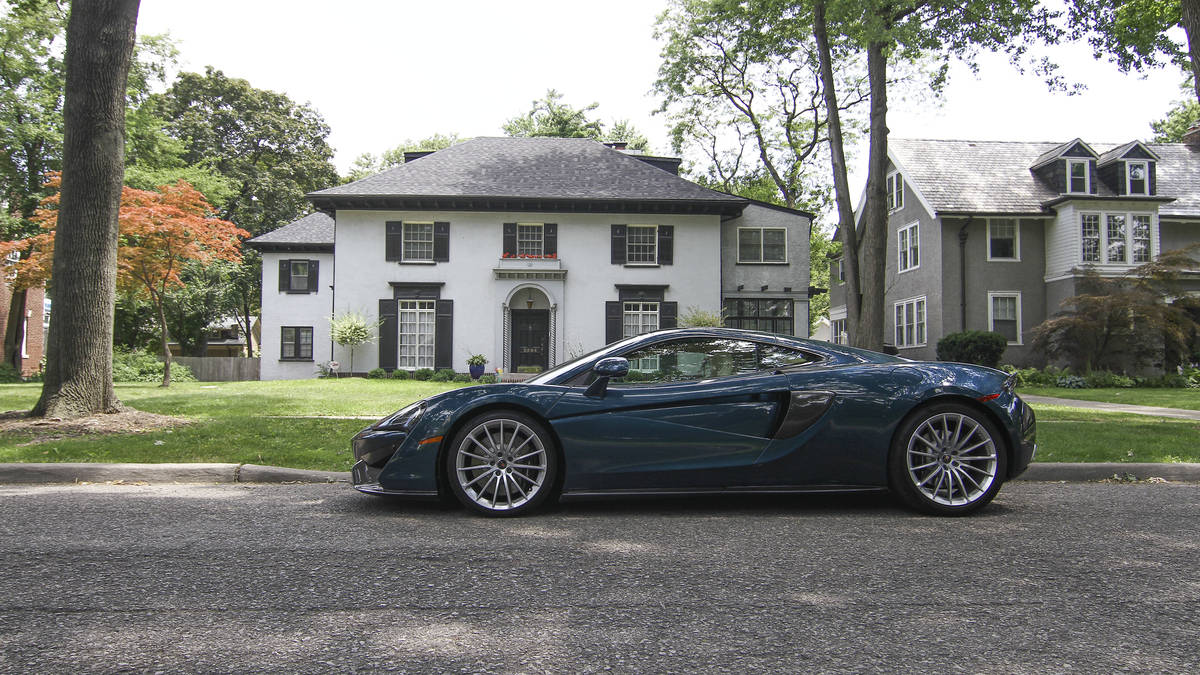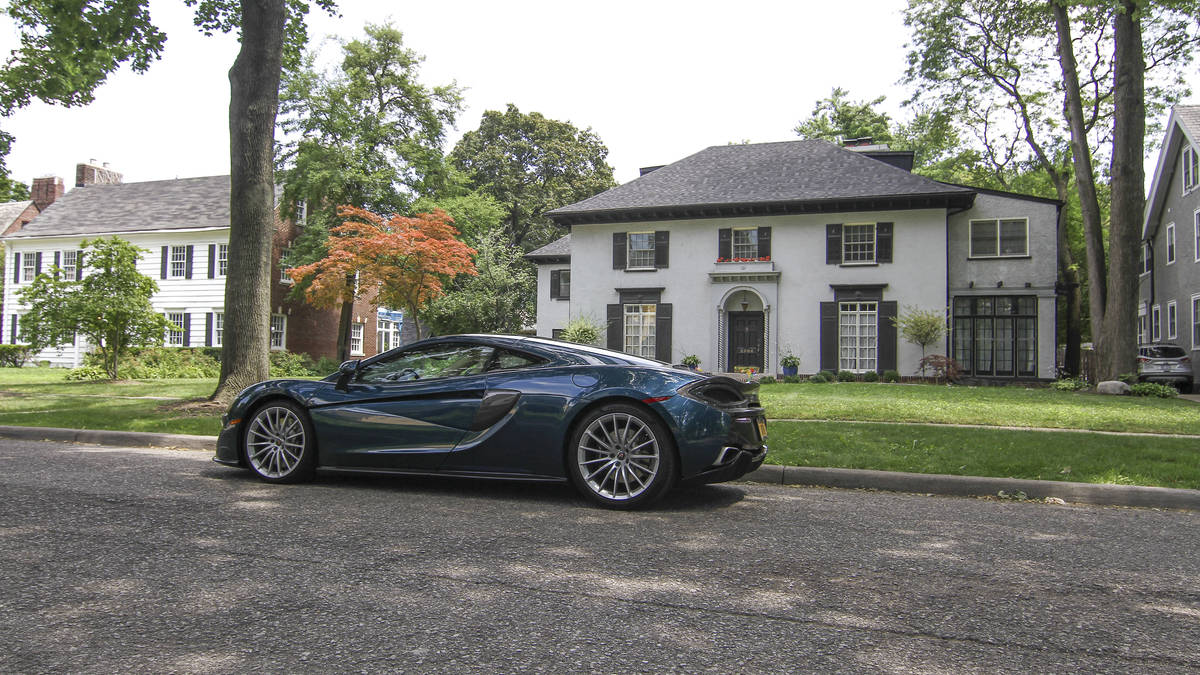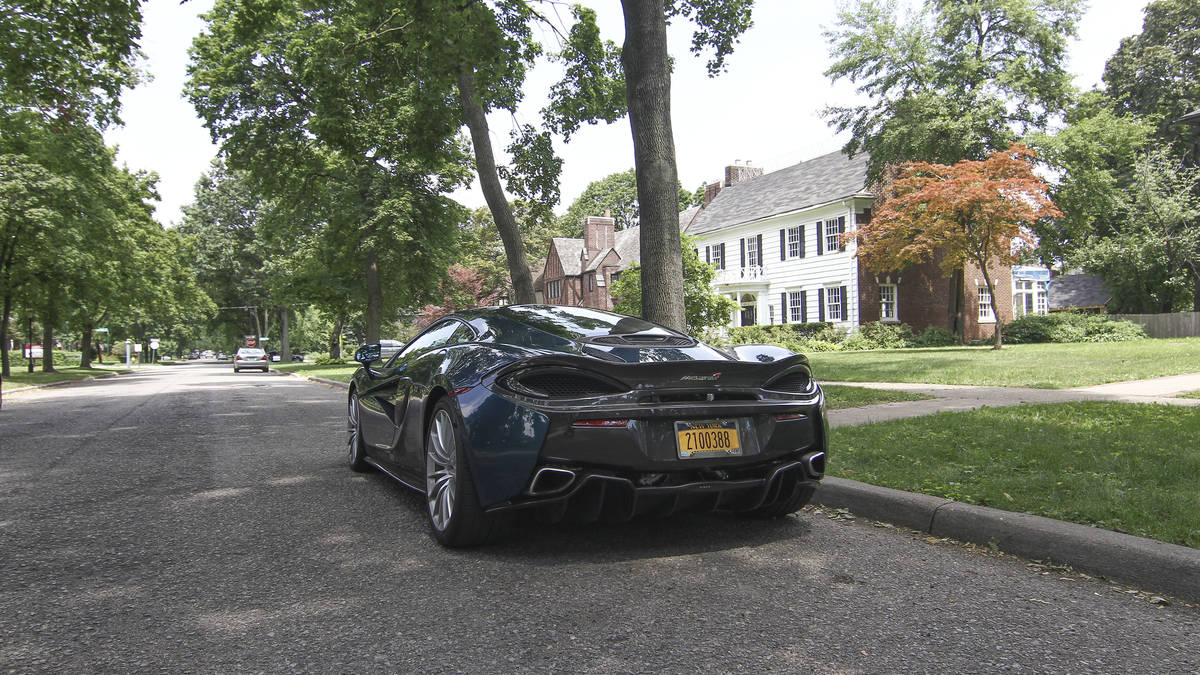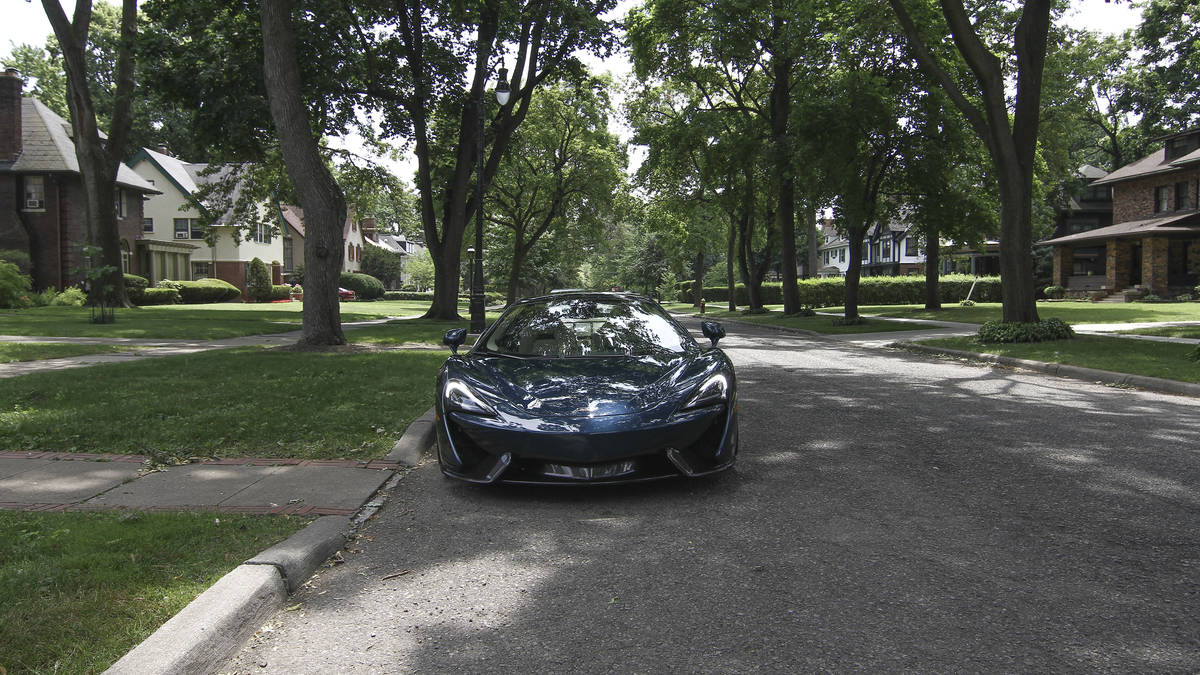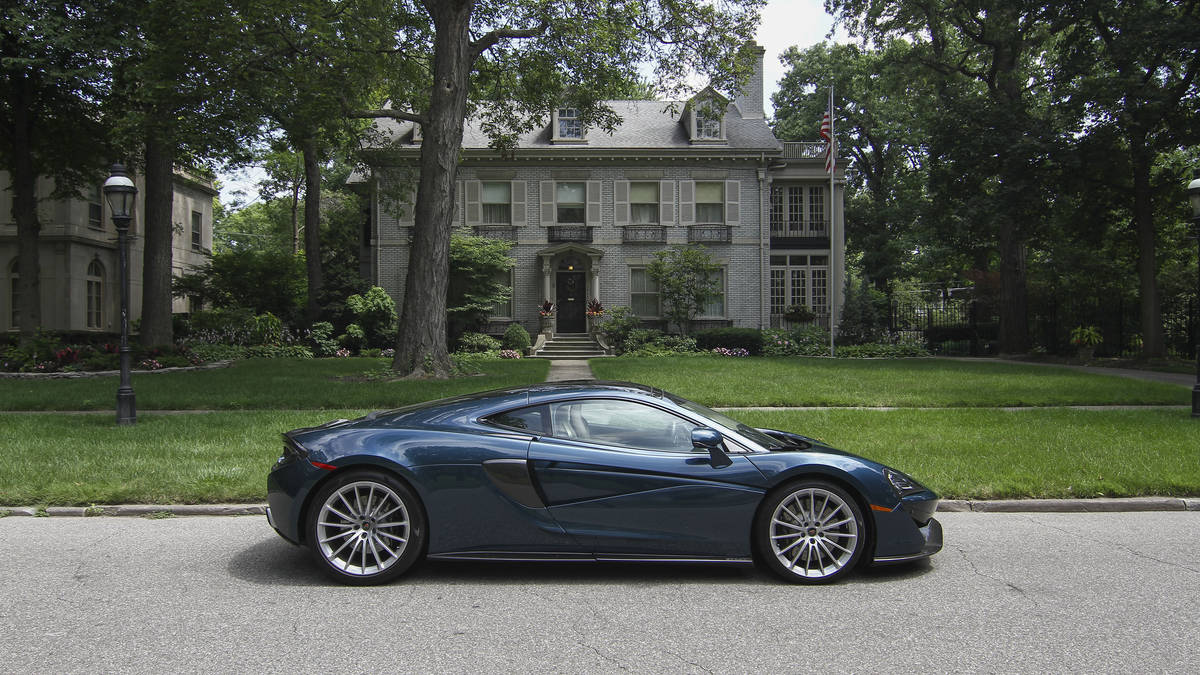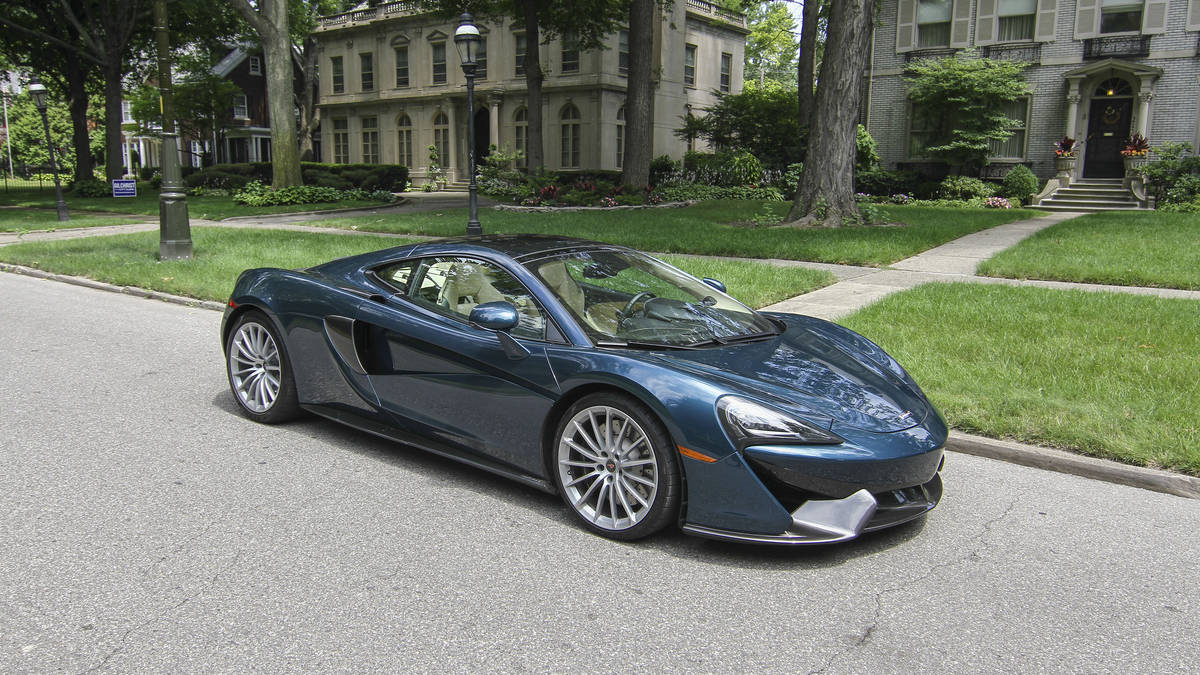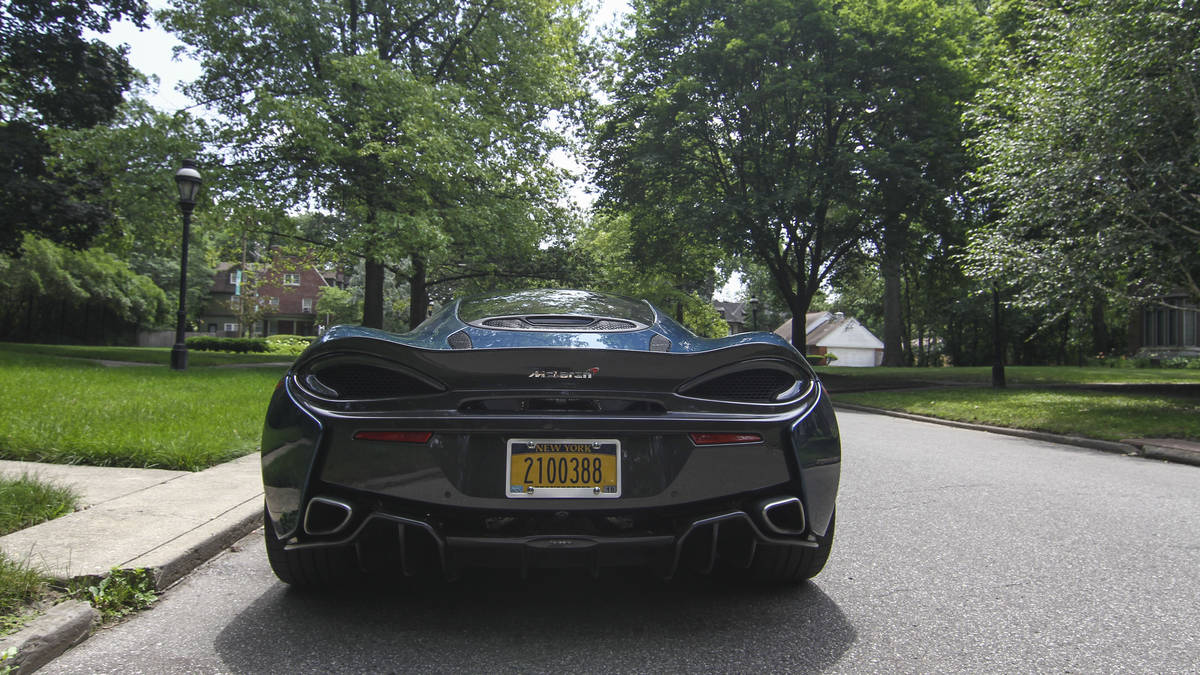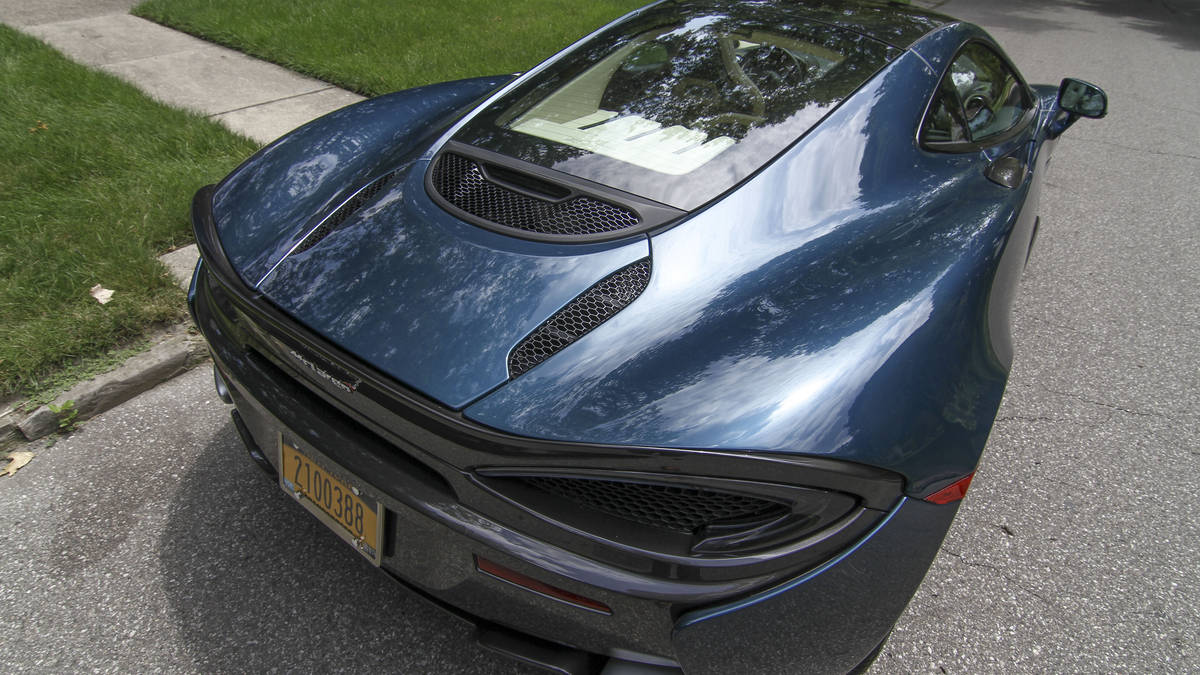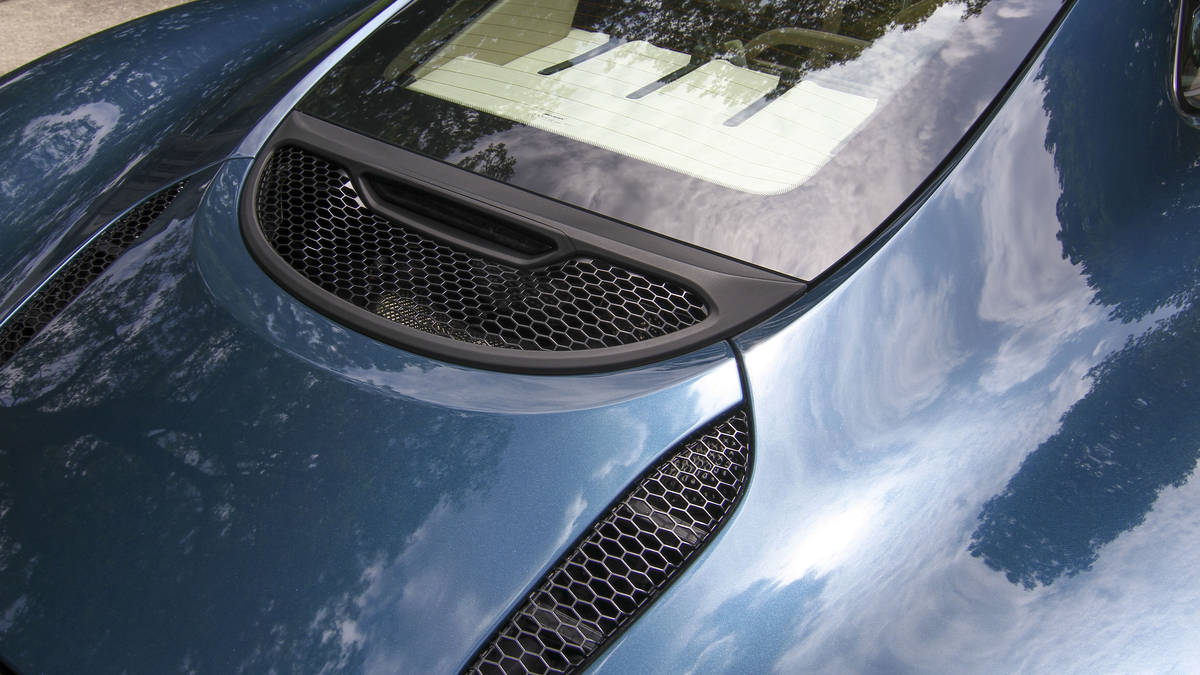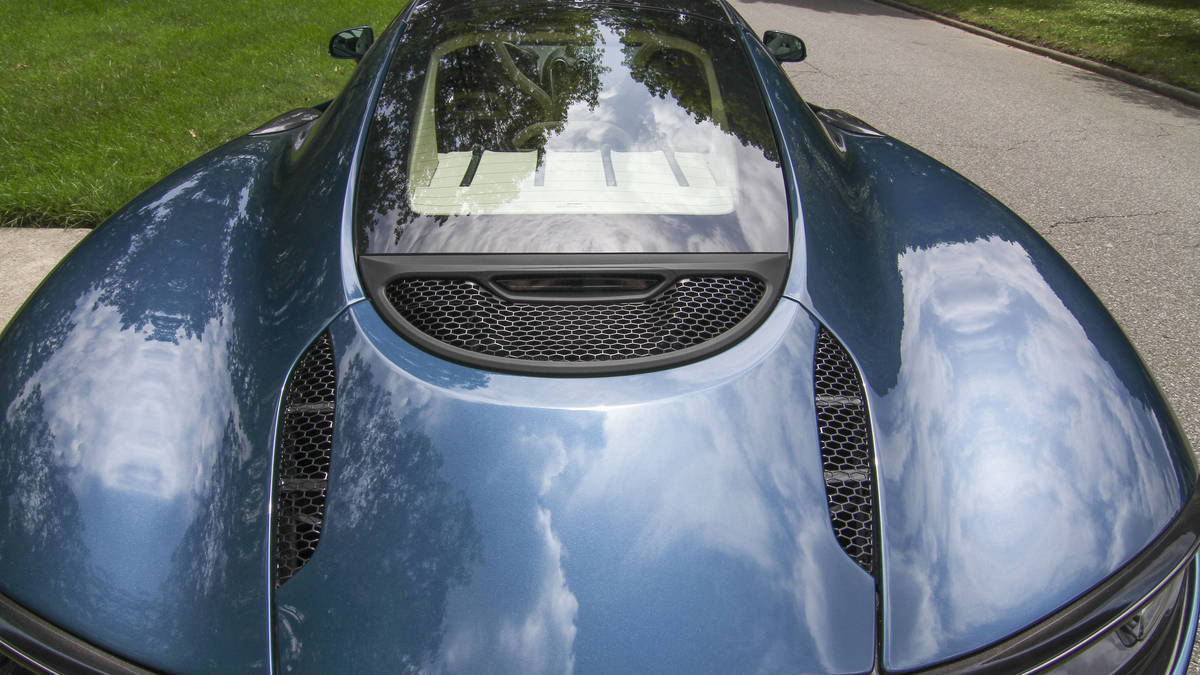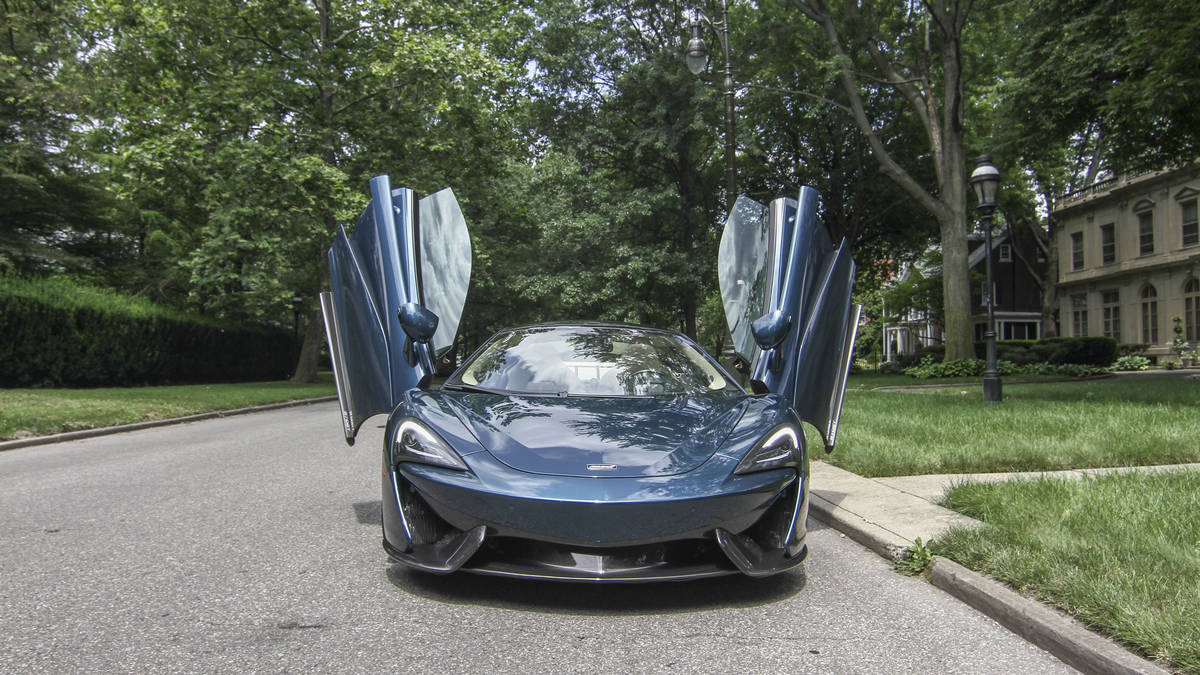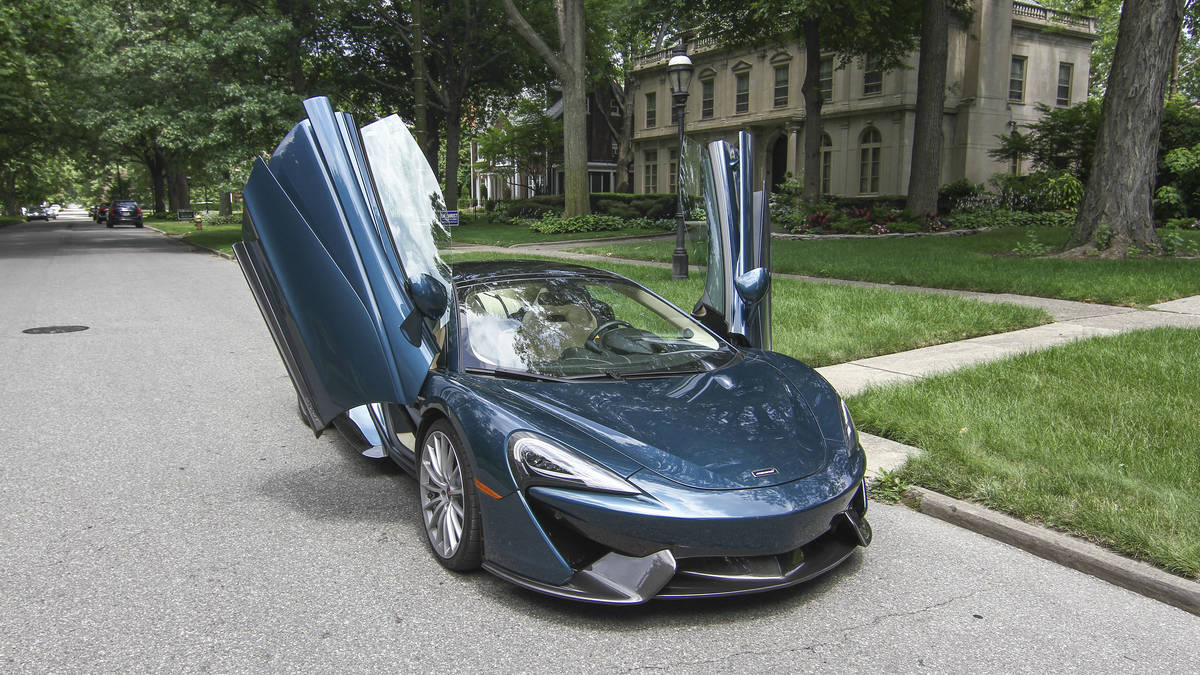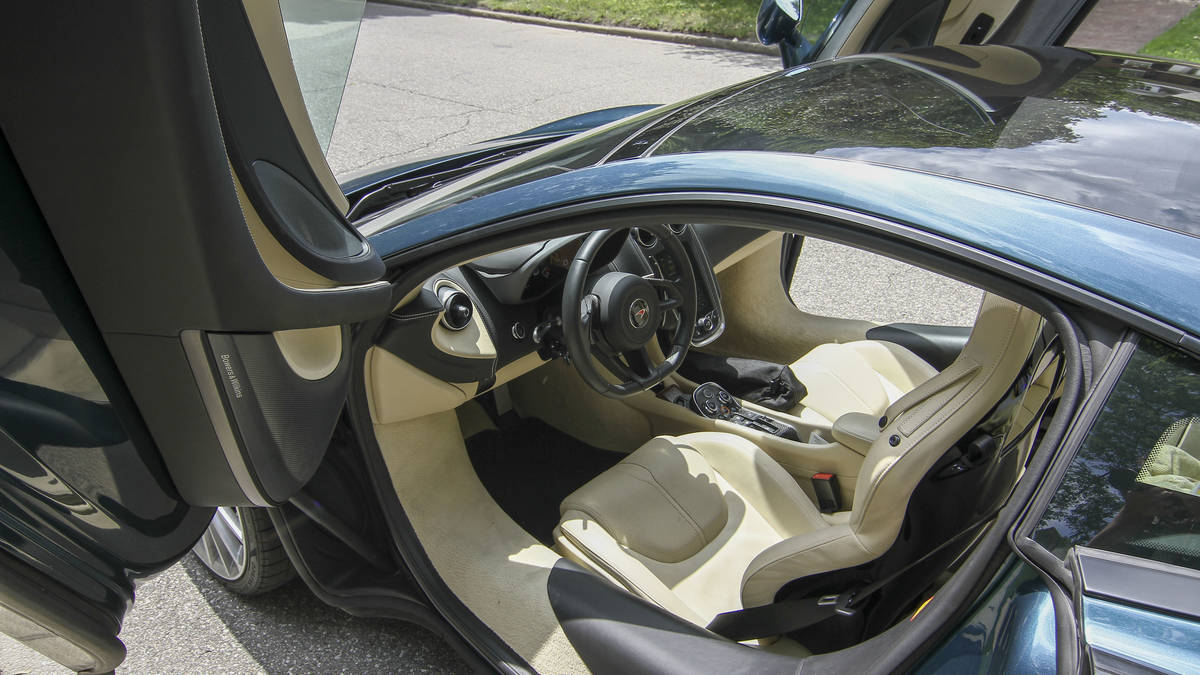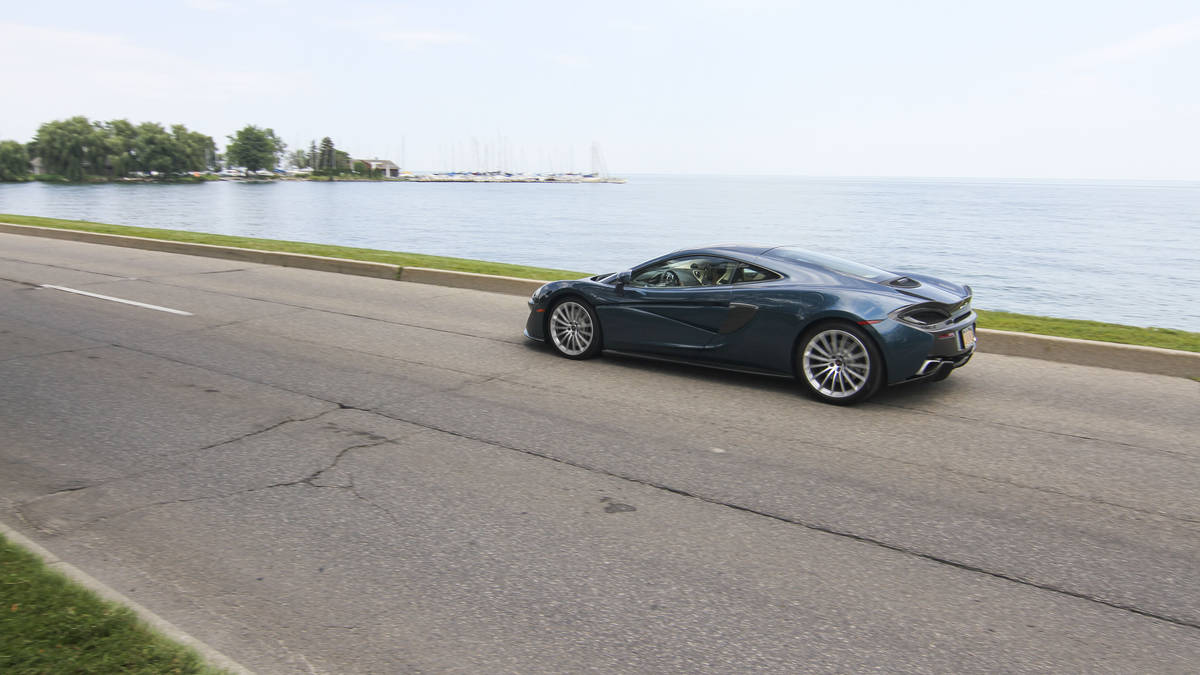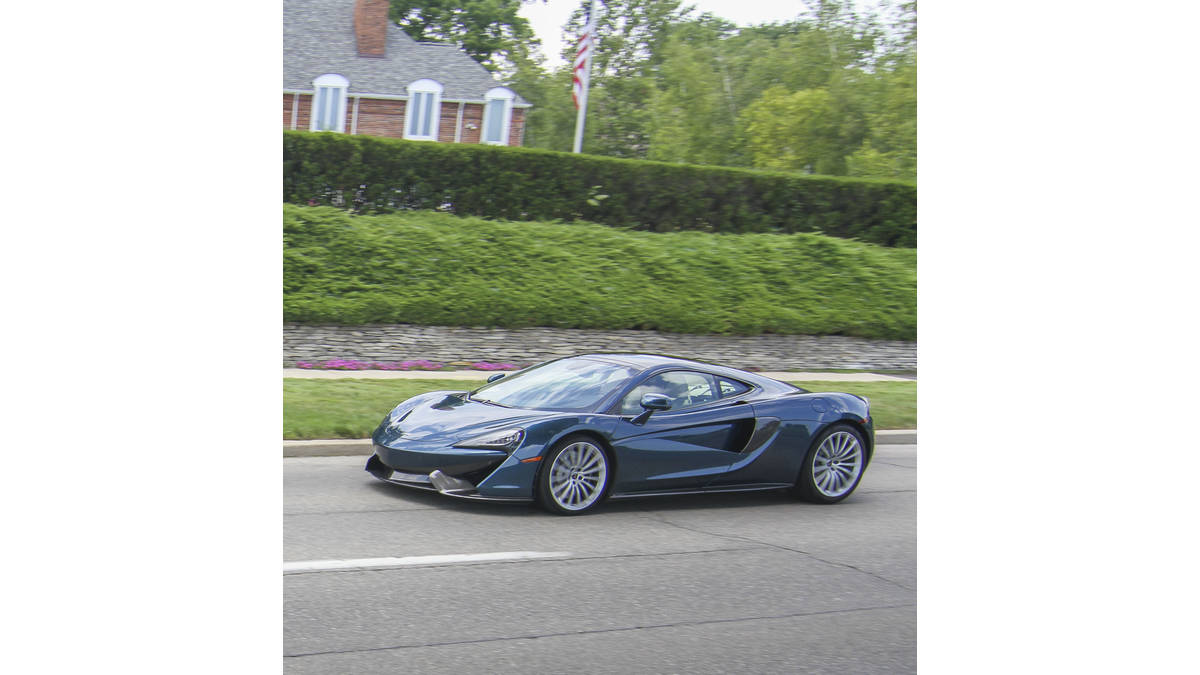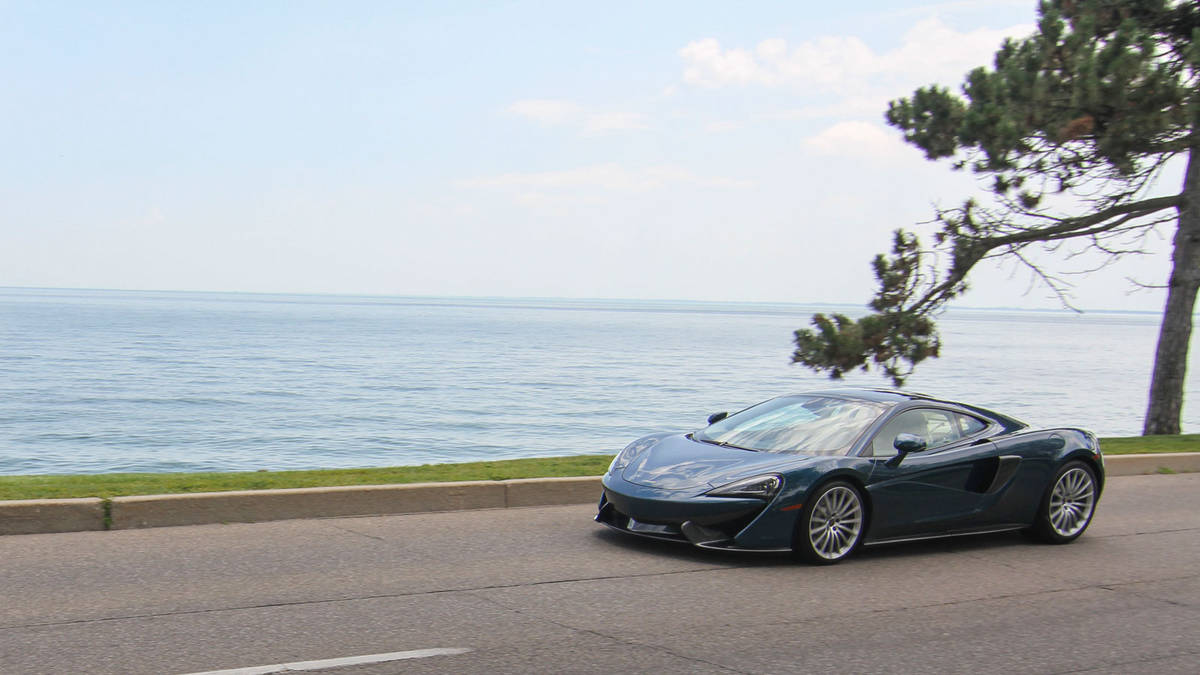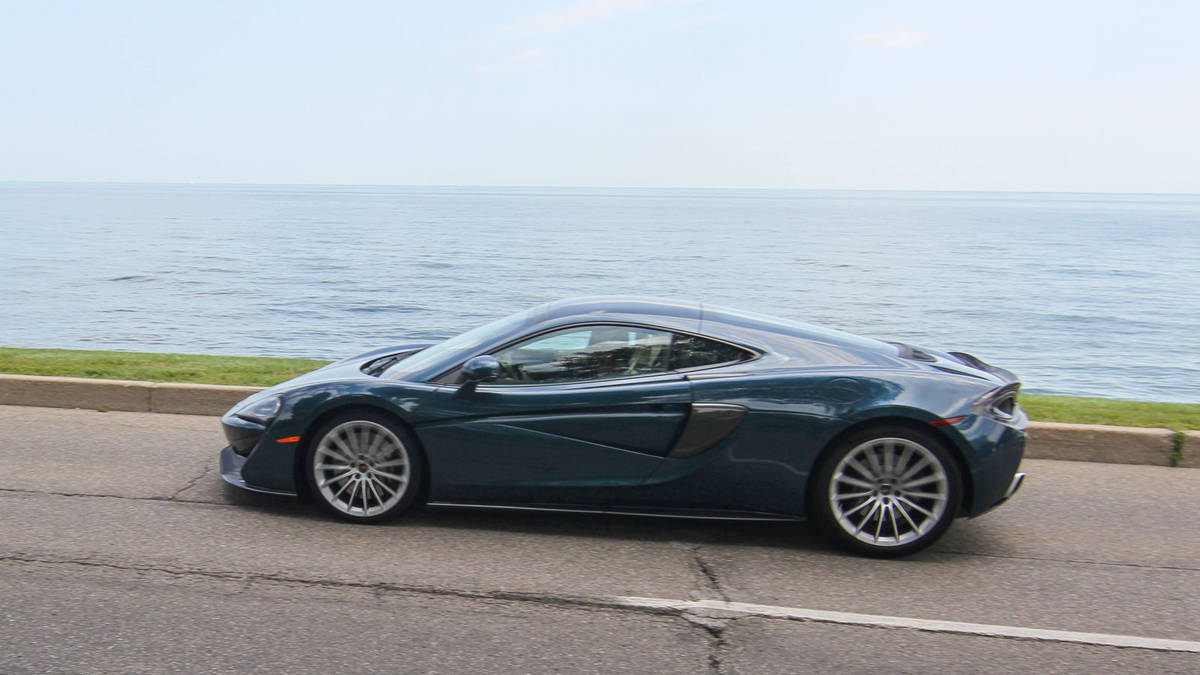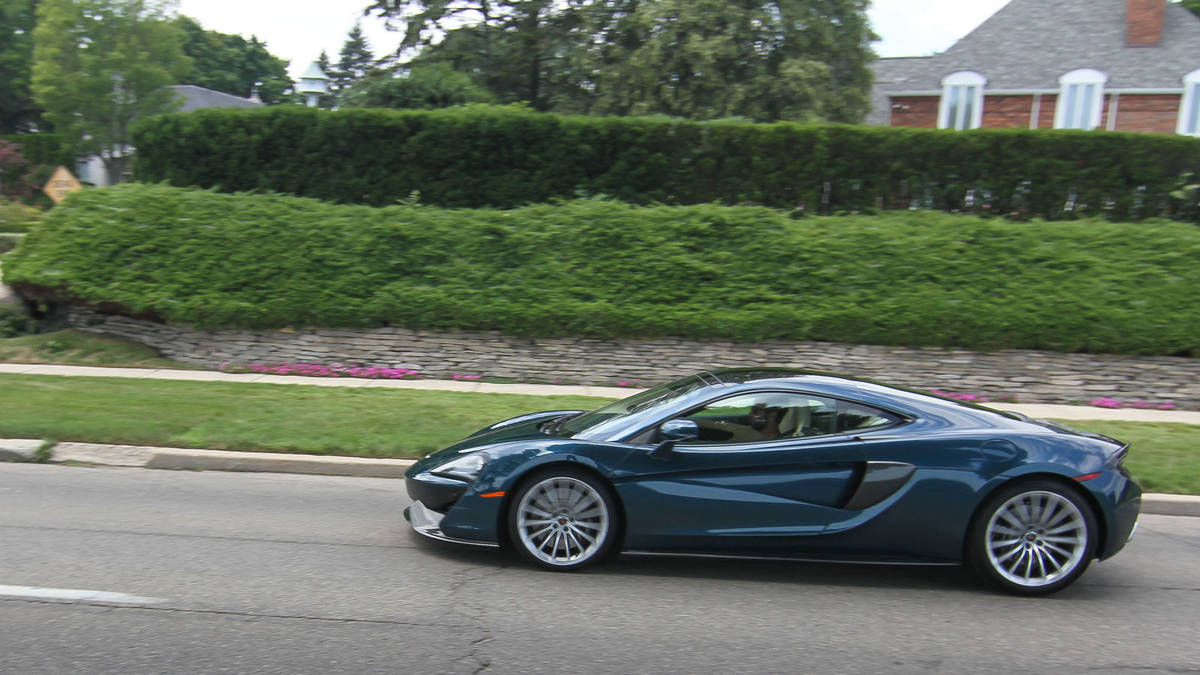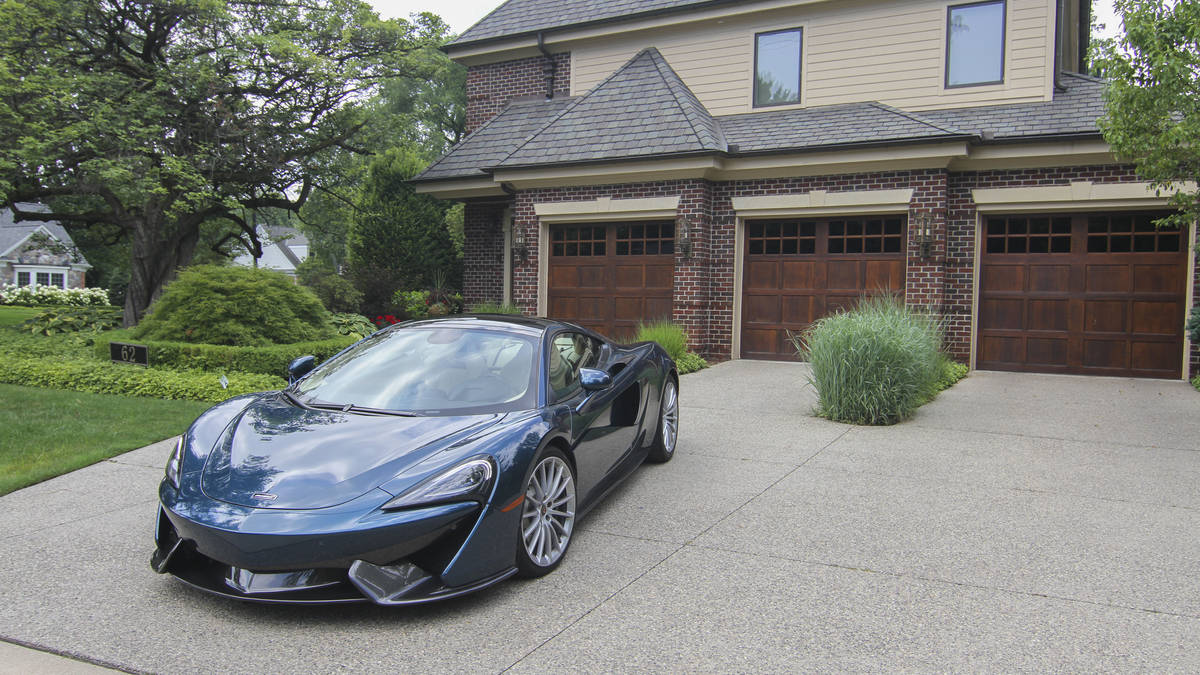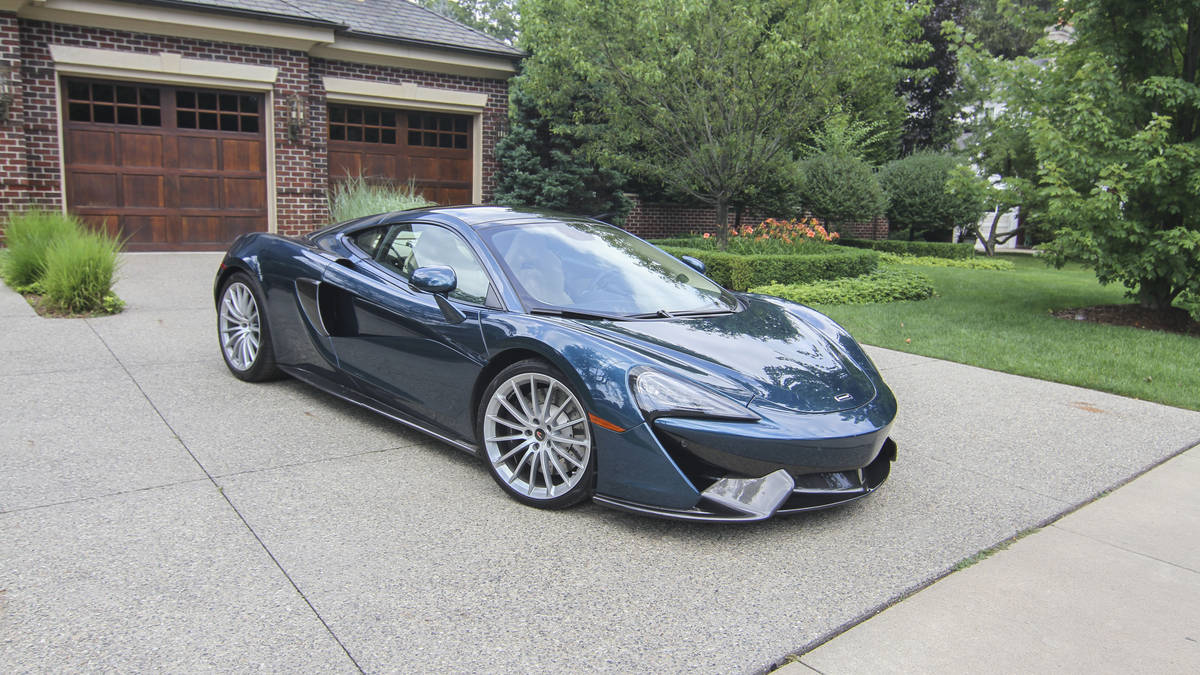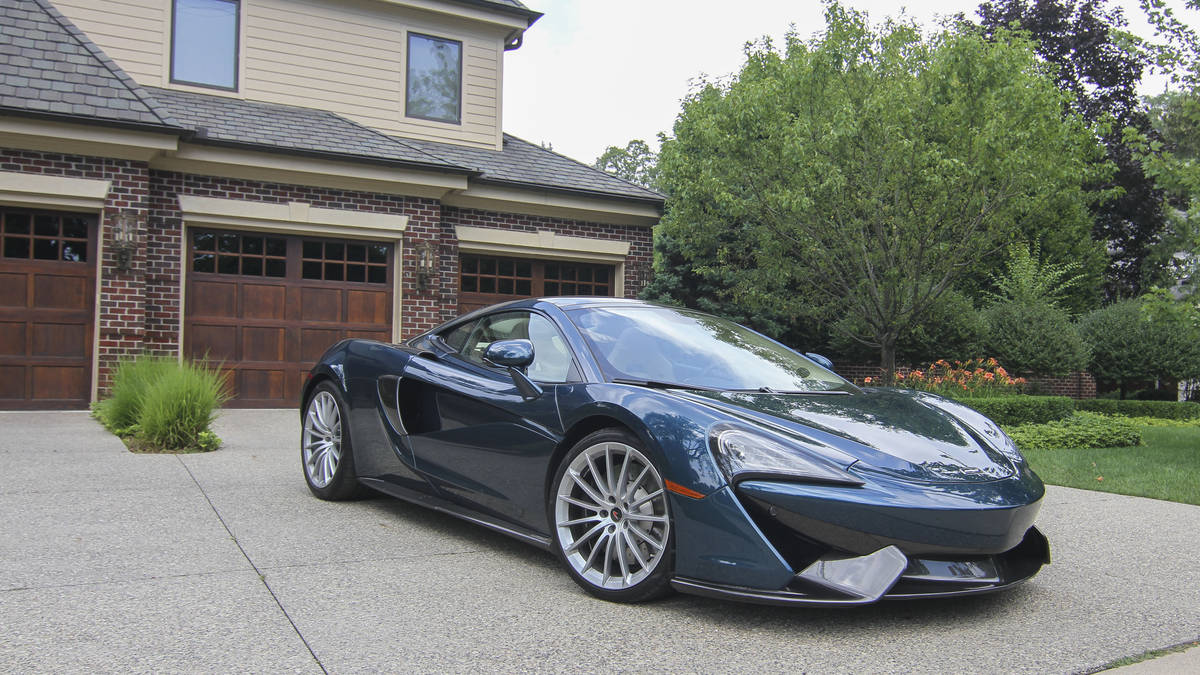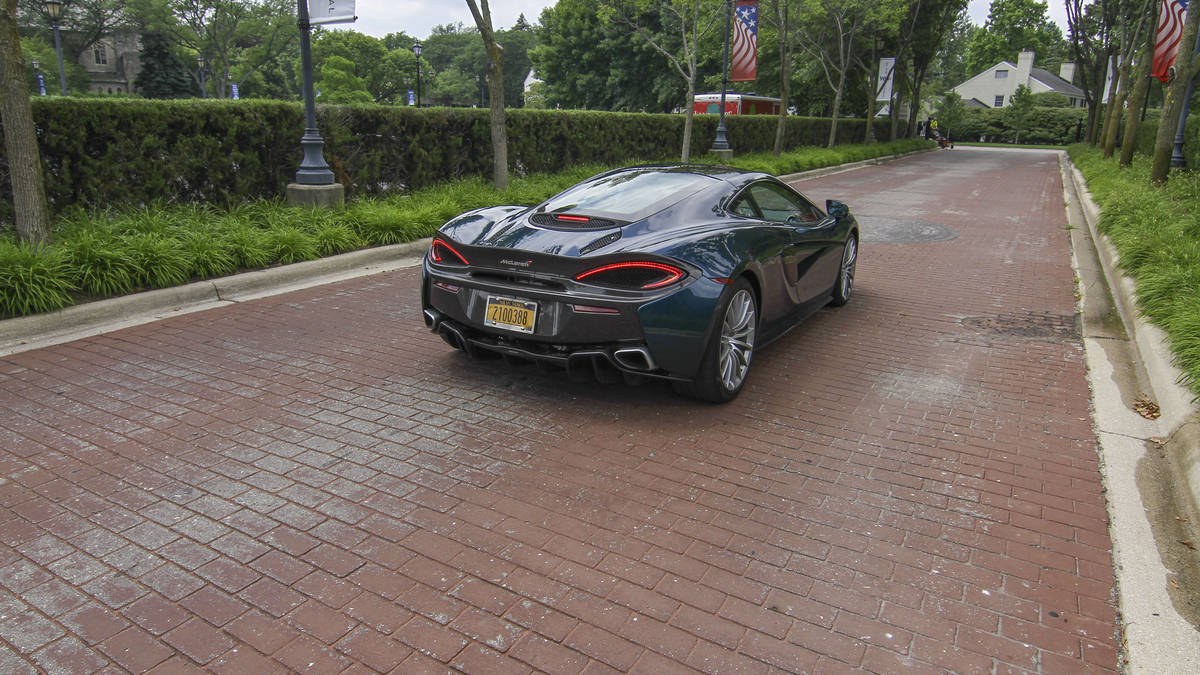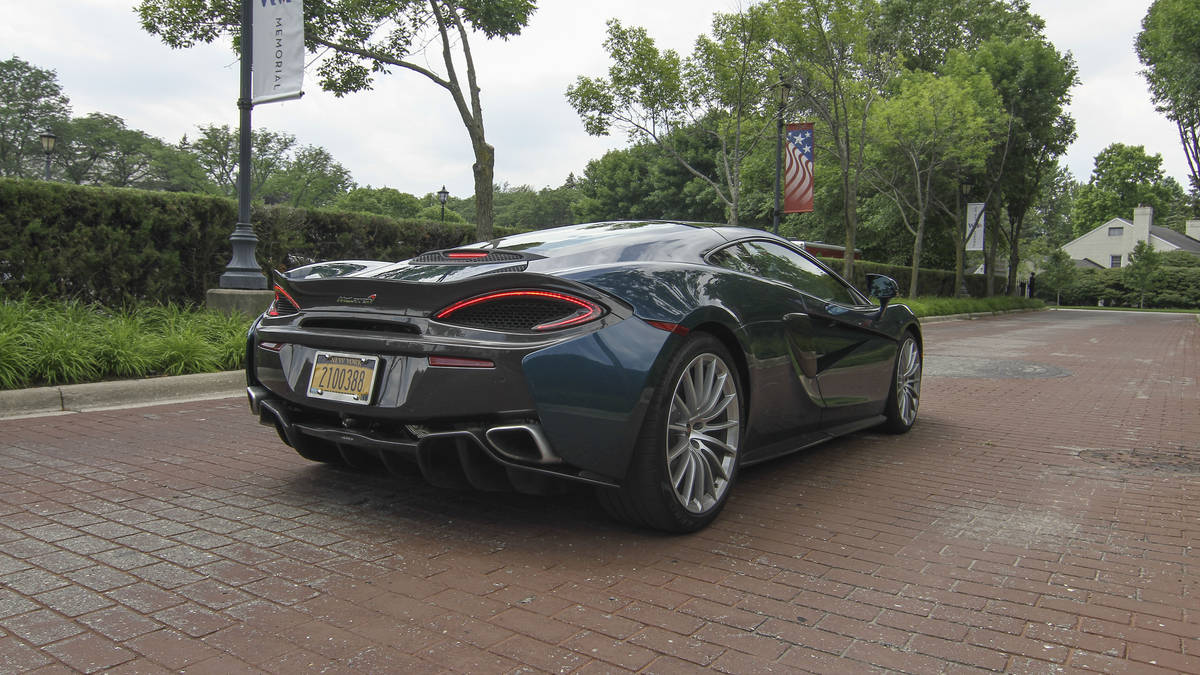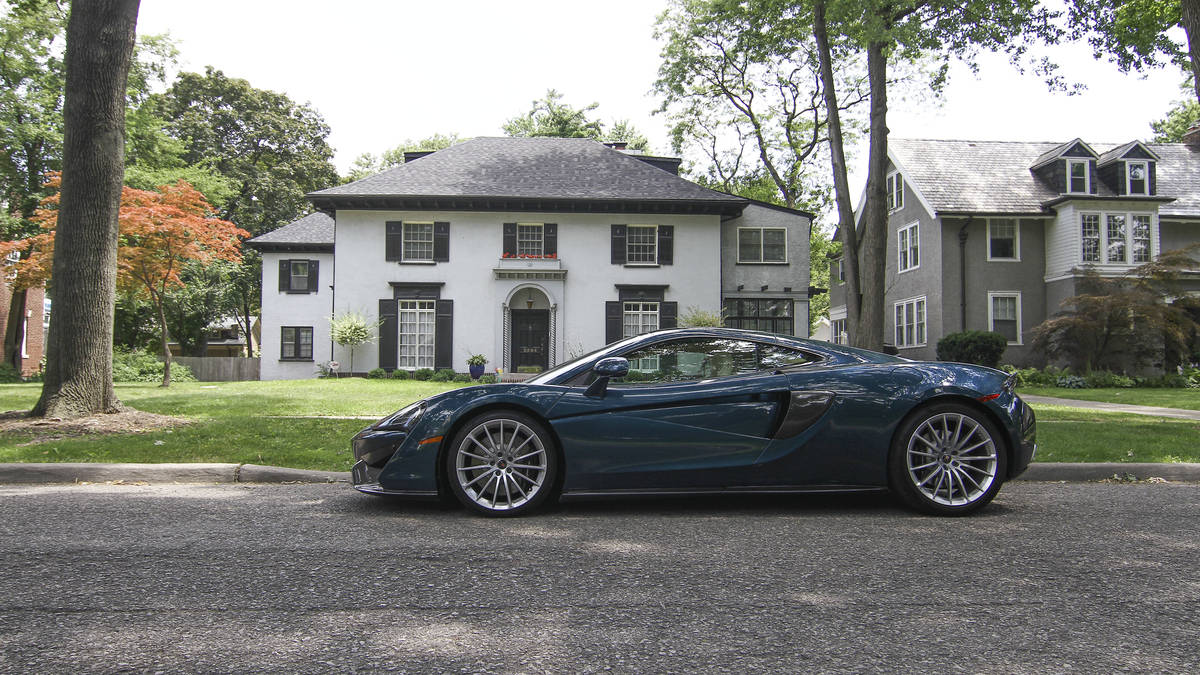The McLaren 570GT cooks. It cooks with speed on the highway, the cabin cooks thanks to a full length panoramic sunroof above and the mid-mounted engine really cooks, enough to send heat wafting from the rear vents after only a short drive. The color, however? A cool turquoise shade named Pacific blue.
Even in that color we can’t say the 570GT blends in, but compared to the 570S we drove last year, in arrest-me-red, it slips under the radar just a little bit, more so at night.
So, the S and the GT aren’t very different cars, but there are some notable changes for the grand touring model, starting with the quieter exhaust system. It doesn’t rip, pop and snort as much as the S, which left this reviewer a little cold.
The GT is 15 percent softer in the front and 10 percent in the rear. You’ll still be dodging the big potholes but nothing really makes you wince.
The steering gets a slightly reduced ratio to smooth inputs, but is still both quick and easy. The car feels light all around with strong brakes and a still-touchy throttle. Of course, matting it from a stoplight makes both the S and GT feel light, especially when a factory fresh Mustang GT350 falls from your peripheral vision to your side mirrors, to your rearview.
Other changes between the S and GT include more comfy, fully automatic seats, electric steering column, a nose lift, which we’ll get to later, more speakers, a little more storage with the clamshell rear hatch, quieter tires and that huge panomaric roof, cooking the car in Michigan’s summer heat. Just keep the AC on max and give yourself a few minutes before jumping in. And don’t touch the rear engine cover either. It’s hot.
It’s a McLaren, so you’re going to have a good time no matter where you’re driving it. Like I said about the S, it’s Porsche-911-Turbo money, but it gets way, way more looks than the squashed bug. I was cruising Woodward Avenue on a weeknight and the swarm of cars circling me got so annoying, I blasted back toward the expressway tunnels this car likes to call home. An orange MP4-12C also caught up, with a younger guy driving. He gave me a quick peace sign before taking off into the night.
Even with a bit less sound from the pipes, it’s still simply awesome to listen to. I took all my normal tunnel commutes and added a few others before I finally dropped the car off. It sounds almost like an F1 car at full tilt. It’s not a high-pitched scream — more a bassy, middle C, just getting louder as the revs climb, with a little turbo whoosh for good measure. The 675LT sounded about the same. Might be a little less musical than a Ferrari, but no less thrilling.
It takes a split second after flattening the throttle for this GT to get going, but after that it’s a never-ending wave of thrust, at least through 5 of 7 paddle shift changes. There’s one big — scratch that, huge — problem though: The paddles are in the correct format, the left is downshift, right is upshift, but they’re on a rocker and made from one hunk of carbon fiber. In theory the setup lets you change up or down with either paddle. The problem? Sometimes you just flick the upshift side with a fingertip and instead of going up a gear, it bounces back and goes down a gear. That’s not the end of the world on the street, but on the track, it could be catastrophic. This probably wouldn’t be a problem if you owned the car, but it’s the first time I’ve noticed such a thing.
The seven-speed dual-clutch has three different shift modes through normal, sport and race. Race gives the driver a nice shove in the small of the back no matter where you shift. It’s the car saying, “I have plenty more to give, go for it!” Sport is a little softer; normal, even softer.
The gauges change as the modes change and race mode has the coolest one. It’s sort of an ’80s digital throwback but it also tells you when to shift. You can see it in your peripheral vision, so you don’t have to take your eyes off the road.
The 570GT has a few other issues, mostly small. The pedalbox is narrow so people with big feet, or people who feel the need to manspread, might have an issue. Rear visibility isn’t great with the small rear window and the seat controls are hidden very low on the sides of the buckets. I also couldn’t figure out the memory function so I had to readjust each time I got in. It’s part of the convenience entry and exit function, so it makes it easier to climb out, but I’d trade that for the perfect driving position easily.
The nose lift function is almost necessary in car like this. My driveway is a little steep so I had to use it every time, and it takes a few times to get quick at it. All you need to do is flick the left stalk about 10 seconds before you need it. And then remember to tap it down when you’re back on the street. It also lowers automatically around 35 mph.
Sometimes though it moves you into a setup mode, which you’ll have to back out of and then hit the stalk up again.
The car can also get loud while idling. With the AC on the radiator fans, located near the doors, make a ton of noise. Same when the nose is raising or lowering. I don’t know if there’s a compressor in there or something but sitting at idle, you have to talk loudly for a passenger to hear you.
Last complaint: the damn passenger side seatbelt warning goes off if you have anything heavier than a feather sitting there. And it’s not like this car has a ton of room for stuff. During the summer I usually take my light jacket along to carry all my stuff—cigarettes, wallet, work keycard, keys and such. You have to either throw it all on the floor or grab the seatbelt and buckle it. There’s definitely no turning it off.
The cabin looks great in our car’s cream color and the driving position, besides where your feet rest, is perfect. McLaren took the opposite tack Ferrari did with the steering wheel. Ferrari has everything within a finger’s reach including the start button, mode control, windshield wiper, turn signals and probably more. McLaren’s wheel is just a naked piece of carbon fiber. I think the McLaren’s is cooler, and after an impromptu poll in the office, about two-thirds think the same.
The single screen radio/infotainment works well once you get used to it. It connected with my iPhone without a hitch but it does react weirdly to polarized sunglasses. You have to tilt your head sometimes to see what you’re looking for.
Looking back at what I wrote about the 570S, most of it rings true here. There’s plenty of competition around this price point. A few AWDers and a few RWDers, no manual transmissions, but a McLaren is something different. In the nicer parts of southeast Michigan you see a few Ferraris a day, at least when the weather’s nice. I talked to a valet who said in the past year he’s seen tons of Italian exotics, but just two McLarens, including this one. There’s something to be said for that. And at this lofty performance perch, and price, the buyer should get exactly what he or she wants, including exclusivity.
As far as the 570 fraternal twins go, the GT offers a few more creature comforts than the S and for that, and for Pacific blue, it gets the nod.
We suggest wearing shorts and keeping sunglasses close by, and turn the music up to drown out those damn cooling fans.
2017 McLaren 570GT Press Release
McLAREN EXTENDS THE APPEAL OF THE SPORTS SERIES IN GENEVA WITH THE 570GT
- The most luxurious and refined of any McLaren to date with a light, airy cabin upholstered and specified with the highest quality materials throughout
- Side-opening rear glass hatch offers an additional 220 litres of storage on the leather-lined Touring Deck
- Fine-tuning to the suspension and steering systems to emphasise long distance comfort
- Bespoke P Zero™ tyres, developed in conjunction with technical partner Pirelli, includes innovative Pirelli Noise Cancelling System (PNCS) for more refined ride
- Classic GT lines and unique aerodynamic package, including an extended fixed rear spoiler
- Pricing starts at £154,000 in the UK
- Global reveal to take place at the McLaren Automotive stand, Stand 6040, Hall 6 at 10.00CET (09.00GMT)
McLaren Automotive will showcase the largest selection of models to date at this year’s Geneva Motor Show with the full three tier model range on display, including the latest in the recently-launched Sports Series – the McLaren 570GT. Practical enough for everyday use, the two-seat, mid-engined sportscar 570GT is the most refined and road-biased McLaren yet, designed with a focus on day-to-day usability and long distance comfort. It offers increased levels of practicality and comfort, while remaining a true McLaren.
The McLaren 570GT joins the 570S Coupé and 540C Coupé as the third model in the recently announced Sports Series family. The clean lines of the revised glasshouse give the 570GT a sleek and refined silhouette, and mark out the second of three bodystyles which will eventually complete the Sports Series. A standard fixed glass Panoramic Roof provides a bright, open cabin running through to the large rear glass hatch creating the most luxurious and relaxing McLaren driving environment. As seen on the other models in the Sports Series, levels of craftsmanship throughout the interior of the 570GT are of the highest level, upholstered and specified with quality materials and the latest technologies throughout.
EVERYDAY USABILITY
The 570GT is the most practical model ever launched by McLaren Automotive, targeted towards longer journeys and weekends away. As with all Sports Series models, ingress and egress are optimised through a lower and narrower sill, while the signature dihedral doors open with a more upward arc. Within the spacious and ergonomically-optimised cabin, a pair of eight-way electrically adjustable sports seats are upholstered in leather as standard. The control interfaces for the air conditioning, telephony, navigation and audio systems are managed through the centrally-mounted touchscreen, while vehicle setup is configurable via the TFT LCD digital instrument cluster.
The standard fixed glass Panoramic Roof provides a bright, open cabin with a dramatic glasshouse design running through to the large rear glass hatch. The roof glass is treated with 18 percent transmission tint – the same as the glass roof of the McLaren P1™ – and also features SSF (Sound & Solar Film) to absorb solar radiation while providing additional noise insulation. With the increased glass area of the 570GT, cabin temperatures are regulated and maintained by an enhanced dual-zone air conditioning system. The system allows fully automatic and independent settings for passenger and driver. A two-stage Automatic function – ‘Auto’ and ‘Auto Lo’ – allows a desired temperature to be obtained, with the latter setting limiting the speed of the fans to minimise fan noise within the cabin.
The front luggage area remains unchanged from the Coupé, providing 150 litres of stowage, while a further 220 litres of space is available behind the seats on the leather-lined Touring Deck. This additional space is accessed via the side opening Glass Hatch bringing the total storage space for the 570GT to 370 litres. The Glass Hatch opens on the kerbside whether left- or right-hand drive and is framed by carbon fibre providing significant torsional rigidity.
Refinement and day-to-day usability are further enhanced through the latest tyre technology from McLaren Automotive technical partner, Pirelli. The 570GT features specially developed Pirelli P Zero™ tyres which reduce in-cabin road noise by up to three decibels. The unique characteristic of the tyre is the innovative Pirelli Noise Cancelling System (PNCS): a new technology patented by Pirelli that reduces road noise from the grooves within the tyre, designed to absorb vibrations and reduce transmission into the cabin.
CRAFTSMANSHIP
As with all models in the Sports Series, the 570GT is extensively equipped throughout with the latest technologies and the highest quality materials. As standard, the new model features extended leather upholstery, electrically adjustable heated seats with memory function, front and rear parking sensors, an electric steering column with easy entry / exit function, soft close doors and a quieter exhaust system compared to the 570S Coupé. Lightweight noise absorbing and damping materials are used to line the Touring Deck and bulkhead, further enhancing the level of refinement within the cabin.
Available from launch are a range of ‘By McLaren’ designer interior specifications, designed to demonstrate the breadth of personalisation available. As with the 570S Coupé, these are available in a choice of Luxury or Sport configurations, and are designed to showcase the interior design of the 570GT, and compliment the exterior colour choices.
The eight speaker McLaren Audio Plus system is fitted as standard. This system – optional on the 570S Coupé – includes two 100mm mid / bass drive units adding to the clarity and depth of the sound, and two 25mm tweeters in the rear of the cabin which balance the sound to ensure the occupants have a greater sense of immersion. A 12-speaker Bowers & Wilkins system is also available re-tuned to the different interior acoustics of the 570GT. The system comprises five 25mm aluminium Nautilus tweeters, five 100mm Kevlar® mid-range drive units and two 200mm carbon fibre & Rohacell bass subwoofers. All speakers are driven by a fully digital 14-channel 1280W Class D amplifier.
THE DRIVE
Under the skin, the 570GT has been developed with a unique dynamic setup to reflect its positioning, while retaining the supercar levels of engagement experienced on the 570S Coupé. Pure McLaren design and engineering combine to produce a car with breathtaking performance yet increased levels of luxury and refinement. Sharing the newly developed suspension system with the other models in the Sports Series, the 570GT emphasises long distance comfort through further fine tuning to the system which includes a reduction in spring rate stiffness of 15 percent at the front and 10 percent at the rear. Independent adaptive dampers can be dynamically adjusted through Normal, Sport and Track settings, and are coupled to front and rear anti-roll bars.
The overall set up of the 570GT has been calibrated to enhance road and motorway driving, and aid ride quality over poor road surfaces. The electro-hydraulic steering system is retained from the Coupé models but with a reduced ratio – by two percent – and has been specifically designed to smooth out driver inputs at high cruising speed.
The 570GT is fitted with the McLaren-developed 3.8-litre twin turbo V8 M838TE engine which debuted in the 570S Coupé. Power and torque remain at 570PS (562bhp) and 600 Nm (443lb ft) and power is delivered to the rear wheels via a seven-speed seamless-shift transmission with adjustment through Normal, Sport and Track settings to produce one of the most rewarding and engaging driving experiences in the sports car class. The settings include bespoke gearchange calibrations with comfort (Normal), Cylinder Cut (Sport) and Inertia Push (Track) technologies all available. As with all models in the McLaren Automotive range, the McLaren 570GT is factory-filled with Mobil 1 New Life™ 0W-40.
DESIGN AND AERODYNAMICS
The revised design of the 570GT sees the glasshouse with clean and sleek lines leading to the rear of the car. With the side-opening Glass Hatch and increased luggage area, the 570GT features a unique aerodynamic package, including an extended fixed rear spoiler – 10mm taller than that fitted to the Coupé models – designed to offer the same levels of aerodynamic performance as the distinctive flying buttresses of the 570S Coupé.
The front end design of the 570GT is shared with that of the 570S Coupé, with the front bumper featuring a pronounced point which generates the centre of pressure, piercing the air to reduce drag and forming four quadrants. This aerodynamic feature is designed to separate the airflow above and below the bodywork, and along each flank. As seen on the other models in the Sports Series, the bonnet features strong crease lines which optimise airflow over the front fenders and into the side air intakes. Aero Blades below the front bumper are angled to produce an area of high pressure ahead of the low temperature radiators.
First introduced on the iconic McLaren F1, and now signature to each of the models in the McLaren Automotive range, the 570GT features distinctive dihedral doors, which open upwards and outwards to aid ingress and egress from the cabin. The design includes a ‘floating tendon’, designed to channel air into the side air intake. Body-coloured door inserts, unique to the 570GT, create a more understated side profile and further differentiate the 570GT from the Coupé models.
LIGHTWEIGHT
As with all McLaren models since the introduction of the MP4-1 Formula 1™ car in 1981, the 570GT uses a carbon fibre chassis. The MonoCell II debuted in the 570S Coupé, and is shared across the Sports Series models. Weighing just 75kg, the lightweight yet extremely stiff chassis contributes to a dry weight of 1,350kg (2,976lb). This equates to 422PS per tonne, providing breathtaking performance more commonly seen in the supercar segment: 0-100 km/h (0-62 mph) in 3.4 seconds, 0-200 km/h (0-124 mph) in 9.8 seconds, with a top speed of 328 km/h (204 mph). Despite supercar performance figures, there have been no sacrifices to the everyday drivability and practicality of the 570GT which returns 26.6 mpg (10.7 l/100 km) on the EU combined cycle and emissions of 249 g/km.
The latest model in the Sports Series is fitted with a lightweight composite braking system. Set up with a greater focus on road driving, the system includes iron discs (front 370mm x 32mm / rear 350mm x 30mm) with four-piston callipers front and rear. In front of these sit a set of unique 15-spoke GT Design cast alloy wheels – 19-inch front, 20 inch rear. The newly-designed wheels are fitted exclusively with Pirelli tyres. As standard, road-focused P Zero™ tyres are fitted, while a more performance-focused P Zero™ Corsa option is also available.
The 570GT is priced from £154,000 in the UK, with first deliveries due to commence late in 2016.
2017 McLaren 570GT Photos
2017 McLaren 570GT Quick Specs
McLAREN 570GT TECHNICAL STATISTICS
PERFORMANCE
| 0-100 km/h (0-62 mph) 0-200 km/h (0-124 mph) 0-400m / ¼ mile Top speed Power-to-weight |
3.4 seconds 9.8 seconds 11.1 seconds @ 213 km/h (132 mph) 328 km/h (204 mph) 422PS per tonne |
BRAKING
100-0 km/h (62 mph) 33.0 m (108 ft)
200-0 km/h (124 mph) 133 m (436 ft)
ENGINE & POWERTRAIN
| Engine Configuration Power Torque Transmission CO2 Fuel consumptionEngine lubricant |
V8 Twin Turbo / 3799cc 570PS (562 bhp) @ 7,500 rpm 600Nm (443 lb ft) @ 5,000-6,500 rpm 7 Speed SSG 249 g/km combined – 26.6 mpg (EU), 10.7 l/100 km urban – 17.2 mpg (EU), 16.5 l/100 km extra urban – 38.4 mpg (EU), 7.4 l/100 km Mobil 1 New Life™ 0W-40 |
DIMENSIONS & WEIGHT
Dry weight – lightest 1,350kg (2,976lb)
Weight distribution 42 / 58
Length 4,530 mm
Width 2,095 mm
Height 1,201 mm
Wheelbase 2,670 mm
2017 McLaren 570GT Videos



